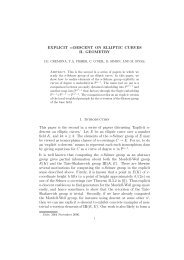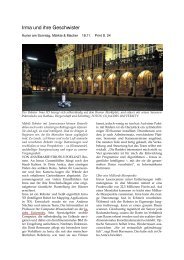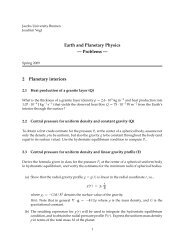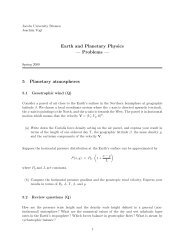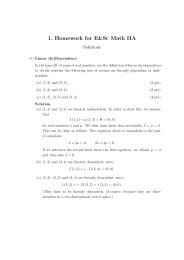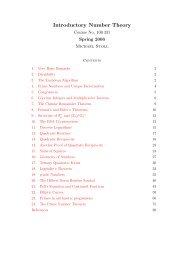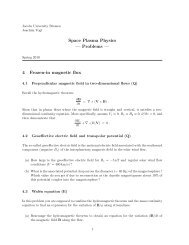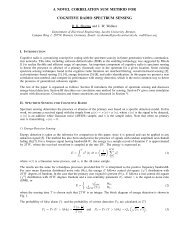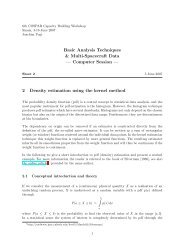Linear Algebra II (pdf, 500 kB)
Linear Algebra II (pdf, 500 kB)
Linear Algebra II (pdf, 500 kB)
You also want an ePaper? Increase the reach of your titles
YUMPU automatically turns print PDFs into web optimized ePapers that Google loves.
26<br />
Proof. We leave the (by now standard) proof that the given maps are linear as<br />
an exercise. It remains to check that they are inverses of each other. Call the<br />
second map γV,W . So let φ : V × W → F be a bilinear form. Then γV,W (φL)<br />
sends (v, w) to (φL(v))(w) = φ(v, w), so γV,W ◦ βV,W is the identity. Conversely,<br />
let f ∈ Hom(V, W ∗ ), and let φ = γV,W (f). Then for v ∈ V , φ(v) sends w to<br />
(φL(v))(w) = φ(v, w) = (f(v))(w), so φL(v) = f(v) for all v ∈ V , hence φL = f.<br />
This shows that βV,W ◦ γV,W is also the identity map. <br />
If V = W , we write βV : Bil(V ) → Hom(V, V ∗ ) for this isomorphism.<br />
8.8. Example. Let V now be finite-dimensional. We see that a non-degenerate<br />
bilinear form φ on V allows us to identify V with V ∗ via the isomorphism φL.<br />
On the other hand, if we fix a basis v1, . . . , vn, we also obtain an isomorphism<br />
ι : V → V ∗ by sending vj to v∗ j , where v∗ 1, . . . , v∗ n is the dual basis of V ∗ . What<br />
is the bilinear form corresponding to this map? We have, for v = n j=1 λjvj,<br />
w = n j=1 µjvj,<br />
φ(v, w) = ι(v) (w) =<br />
n =<br />
j=1<br />
λjv ∗ j<br />
n ι<br />
n <br />
k=1<br />
j=1<br />
µkvk<br />
λjvj<br />
<br />
=<br />
n <br />
n<br />
j,k=1<br />
k=1<br />
µkvk<br />
<br />
λiµk v ∗ j (vk) =<br />
n<br />
λiµkδjk =<br />
j,k=1<br />
n<br />
j=1<br />
λjµj .<br />
This is just the standard dot product if we identify V with F n using the given<br />
basis; it is a symmetric bilinear form on V.<br />
8.9. Corollary. Let V be a finite-dimensional vector space, and let φ be a nondegenerate<br />
bilinear form on V. Then every linear form ψ ∈ V ∗ is represented as<br />
ψ(w) = φ(v, w) for a unique v ∈ V.<br />
Proof. The equality ψ = φ(v, ·) means that ψ = φL(v). The claim now follows<br />
from the fact that φL is an isomorphism. <br />
8.10. Example. Let V be the real vector space of polynomials of degree at most 2.<br />
Then<br />
φ : (p, q) ↦−→<br />
1<br />
0<br />
p(x)q(x) dx<br />
is a bilinear form on V. It is non-degenerate since for p = 0, we have φ(p, p) > 0.<br />
Evaluation at zero p ↦→ p(0) defines a linear form on V, which by Cor. 8.9 must<br />
be representable in the form p(0) = φ(q, p) for some q ∈ V. To find q, we have to<br />
solve a linear system:<br />
φ(a0 + a1x + a2x 2 , b0 + b1x + b2x 2 )<br />
= a0b0 + 1<br />
2 (a0b1 + a1b0) + 1<br />
3 (a0b2 + a1b1 + a2b0) + 1<br />
4 (a1b2 + a2b2) + 1<br />
5 a2b2 ,<br />
and we want to find a0, a1, a2 such that this is always equal to b0. This leads to<br />
a0 + 1<br />
2 a1 + 1<br />
3 a2 = 1 ,<br />
1<br />
2 a0 + 1<br />
3 a1 + 1<br />
4 a2 = 0 ,<br />
1<br />
3 a0 + 1<br />
4 a1 + 1<br />
5 a2 = 0



